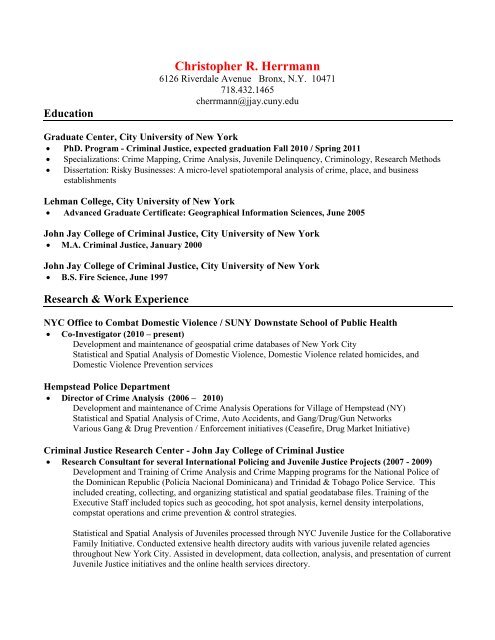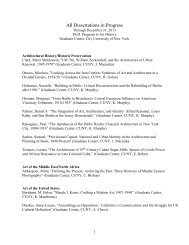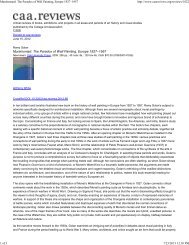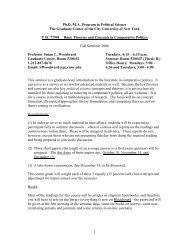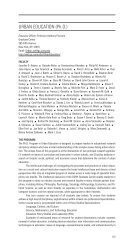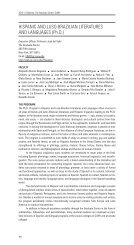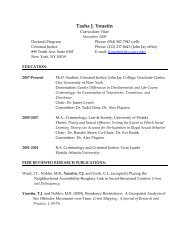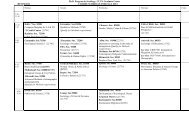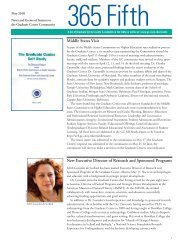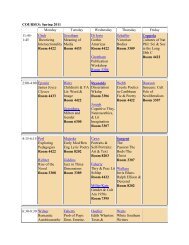Christopher R. Herrmann - CUNY Graduate Center
Christopher R. Herrmann - CUNY Graduate Center
Christopher R. Herrmann - CUNY Graduate Center
You also want an ePaper? Increase the reach of your titles
YUMPU automatically turns print PDFs into web optimized ePapers that Google loves.
Education<br />
<strong>Christopher</strong> R. <strong>Herrmann</strong><br />
6126 Riverdale Avenue Bronx, N.Y. 10471<br />
718.432.1465<br />
cherrmann@jjay.cuny.edu<br />
<strong>Graduate</strong> <strong>Center</strong>, City University of New York<br />
PhD. Program - Criminal Justice, expected graduation Fall 2010 / Spring 2011<br />
Specializations: Crime Mapping, Crime Analysis, Juvenile Delinquency, Criminology, Research Methods<br />
Dissertation: Risky Businesses: A micro-level spatiotemporal analysis of crime, place, and business<br />
establishments<br />
Lehman College, City University of New York<br />
Advanced <strong>Graduate</strong> Certificate: Geographical Information Sciences, June 2005<br />
John Jay College of Criminal Justice, City University of New York<br />
M.A. Criminal Justice, January 2000<br />
John Jay College of Criminal Justice, City University of New York<br />
B.S. Fire Science, June 1997<br />
Research & Work Experience<br />
NYC Office to Combat Domestic Violence / SUNY Downstate School of Public Health<br />
Co-Investigator (2010 – present)<br />
Development and maintenance of geospatial crime databases of New York City<br />
Statistical and Spatial Analysis of Domestic Violence, Domestic Violence related homicides, and<br />
Domestic Violence Prevention services<br />
Hempstead Police Department<br />
Director of Crime Analysis (2006 – 2010)<br />
Development and maintenance of Crime Analysis Operations for Village of Hempstead (NY)<br />
Statistical and Spatial Analysis of Crime, Auto Accidents, and Gang/Drug/Gun Networks<br />
Various Gang & Drug Prevention / Enforcement initiatives (Ceasefire, Drug Market Initiative)<br />
Criminal Justice Research <strong>Center</strong> - John Jay College of Criminal Justice<br />
Research Consultant for several International Policing and Juvenile Justice Projects (2007 - 2009)<br />
Development and Training of Crime Analysis and Crime Mapping programs for the National Police of<br />
the Dominican Republic (Policía Nacional Dominicana) and Trinidad & Tobago Police Service. This<br />
included creating, collecting, and organizing statistical and spatial geodatabase files. Training of the<br />
Executive Staff included topics such as geocoding, hot spot analysis, kernel density interpolations,<br />
compstat operations and crime prevention & control strategies.<br />
Statistical and Spatial Analysis of Juveniles processed through NYC Juvenile Justice for the Collaborative<br />
Family Initiative. Conducted extensive health directory audits with various juvenile related agencies<br />
throughout New York City. Assisted in development, data collection, analysis, and presentation of current<br />
Juvenile Justice initiatives and the online health services directory.
Curriculum Vitae <strong>Christopher</strong> R. <strong>Herrmann</strong><br />
<strong>Center</strong> for Crime Prevention & Control - John Jay College of Criminal Justice<br />
Research Analyst – Operation Ceasefire & Drug Market Imitative – Nassau County (2006 - 2008)<br />
Statistical, Spatial, & Network Analysis of Gangs and illicit drug networks throughout Nassau County<br />
Conducted Gang Member & Turf audits with various agencies throughout Nassau County<br />
Assisted in development, data collection, analysis, and presentation of Ceasefire & DMI methodology<br />
New York City Police Department (NYPD)<br />
Crime Analysis (Supervisor), Office of Management Analysis & Planning, (2004 – 2008)<br />
Spatial Analysis of Crime throughout the New York City Metro area.<br />
Weekly statistical and spatial analysis of shootings & homicides throughout New York City.<br />
Create, Collect, Organize, Distribute computer geodatabase files.<br />
Develop spatial models to forecast future criminal events, hot spots, and high density areas.<br />
Departmental resource allocation of personnel, equipment, and strategic initiatives.<br />
City University of New York - John Jay College of Criminal Justice<br />
Adjunct Professor: Sociology and Law & Police Science Departments, (2003 – present)<br />
Crime Mapping: 2004, 2005, 2008<br />
Juvenile Delinquency: 2003, 2004, 2005, 2009<br />
Criminology: 2004, 2007, 2008, 2009<br />
Introduction to Criminal Justice: 2005<br />
New York State Office of Alcoholism and Substance Abuse Services (OASAS)<br />
Research Scientist, (2000 – 2002)<br />
Conduct Ethnographic research throughout the Mid-Hudson Valley Region<br />
Interviewed recent admissions to Inpatient and Outpatient Drug Treatment Programs<br />
Interviewed recent admissions to New York State Prisons<br />
Teaching Experience<br />
City University of New York - John Jay College of Criminal Justice (2003 – present)<br />
Crime Mapping: This course covers both the theory and practice of Geographic Information Systems<br />
("GIS") for law enforcement and public safety purposes, a technique known as "crime mapping." The class<br />
introduces the theoretical framework for the study of the ecology of public safety, or "crime and place," the<br />
descriptive and analytic procedures of crime mapping, and how spatial analysis is used in designing and<br />
implementing effective programs of crime prevention, problem solving and community policing.<br />
Juvenile Delinquency: The aim of this course is to provide students with an understanding of juvenile<br />
delinquency from a sociological perspective. Theories on juvenile delinquency will be explored and<br />
discussed, as well as their impact on current juvenile justice policy and practices. By the end of the semester,<br />
each student should be familiar with: (1) the major theories concerning juvenile delinquency, (2) the social<br />
causes of delinquency, and (3) have an understanding of current juvenile justice practices.<br />
Criminology: The aim of this course is to provide students with an understanding of the world of crime and<br />
criminology. It is hoped that by the end of the course you will be better able to explain why crime takes place<br />
(theories), where we get data on crime (methods), and better analyze the various types of crime (analysis)<br />
that takes place in our society. As a student of criminology, you should work to develop the ability to<br />
interpret the constantly changing world of crime, become a more informed citizen, and be better prepared to<br />
enter the world of professional criminology and criminal justice.<br />
[2]
Curriculum Vitae <strong>Christopher</strong> R. <strong>Herrmann</strong><br />
Introduction to Criminal Justice: The aim of this course is to provide students with a balanced approach<br />
and comprehensive understanding to the three major areas of criminal justice (police, courts, and<br />
corrections). We will also study the theories, research, and related policy issues, with a focus on generating<br />
student interest in the criminal justice field. The required text is the ultimate tool for student preparation and<br />
provides all of the up-to-date coverage of structural and procedural changes in the criminal justice system<br />
and the critical issues within the criminal justice field.<br />
Teaching Interests<br />
I have instructed or have been a teaching assistant for numerous undergraduate, graduate, and doctoral level<br />
classes at <strong>CUNY</strong> John Jay College of Criminal Justice since 2003. Most of these classes fall under the Criminal<br />
Justice and Sociology course offerings. I also am in the process of developing classes for crime analysis, criminal<br />
justice research methods, intelligence-led policing, problem-oriented policing, geographical profiling, and<br />
environmental criminology.<br />
Research Interests<br />
Strong career interests in Crime Mapping, Spatial Analysis of Crime, related quantitative research methods,<br />
including demographic/census related research, and policy analysis. Experienced in quantitative and qualitative<br />
research including GIS/Remote Sensing projects, ethnographic studies, problem oriented policing and Ceasefire<br />
projects, and computer guided research. Current publication interests include design, implementation, and study<br />
of the relationship between the environment (place) and crime using Geographical Information Science (GISc),<br />
quantitative studies, and related spatial analysis.<br />
Publications<br />
Mapping Population Distribution in the Urban Environment: The Cadastral-based Expert<br />
Dasymetric System (CEDS), 2007 US National Report to the International Cartographic Association,<br />
Cartography and Geographic Information Science, Vol. 34, No. 2, 2007, pp. 77-102<br />
Mapping Auto Theft in the Bronx<br />
Book Chapter in Space, Time, & Crime (Lersch, Carolina Academic Press, 2007)<br />
Crime Pattern Analysis: Exploring Bronx Auto Theft using GIS<br />
Book Chapter in ‘GIS for the Urban Environment’ (Maantay, ESRI Press, 2007)<br />
Diffusion of Heroin in Small and Mid-Sized Cities in New York State<br />
Journal of Addiction, Volume 99, Issue 4 (April, 2004)<br />
By R. Terry Furst, <strong>Christopher</strong> <strong>Herrmann</strong>, Ray Leung, John Galea, and Kirsten Hunt.<br />
Advanced Criminology: Using GIS to teach <strong>Graduate</strong> Students Environmental Criminology Theory<br />
(forthcoming) By Mangai Natarajan & <strong>Christopher</strong> <strong>Herrmann</strong><br />
Location, Location, Location: The Impact of Environmental Variables on Drug Markets- Brooklyn, NY<br />
(forthcoming) By Mangai Natarajan & <strong>Christopher</strong> <strong>Herrmann</strong><br />
[3]
Curriculum Vitae <strong>Christopher</strong> R. <strong>Herrmann</strong><br />
Presentations and Conference Proceedings<br />
Mapping Patterns of Violence in Bronx County, NY<br />
Paper presented, 2010 <strong>Center</strong> for Spatially Integrated Social Sciences – Spatial Pattern Analysis Conference,<br />
University of California at Santa Barbara, July, 2010<br />
Underneath the Hot Spot: What is Causing all that Crime ?<br />
Paper presented, 2010 NYC ArcUser GIS Conference, <strong>CUNY</strong> John Jay College of Criminal Justice, June, 2010<br />
Risky Businesses: A micro-level spatiotemporal analysis of crime, place, and business establishments<br />
Paper presented, 2010 American Association of Geographers Conference, Washington DC, April, 2010<br />
Effective Gang Control — Operation Ceasefire: Nassau County, N.Y.<br />
Paper presented, 2009 NIJ Crime Mapping Conference, New Orleans, LA August 16 - 22, 2009<br />
Crime Mapping & Crime Analysis Deployment Strategies (DDACTS)<br />
NIJ Representative at the Region 8 Meeting of the States, United States Department of Transportation<br />
Lakewood, CO May 26 – 28, 2009<br />
Guns and crime: Mapping patterns and violence<br />
Paper presented, 2008 NIJ Conference, Arlington, VA. July 21-23, 2008<br />
Crime Analysis and Geographical Profiling<br />
Presentation, Academy of Urban Planning (Brooklyn), March 26, 2007<br />
Advances in the Criminal Justice field, educational possibilities, & career opportunities.<br />
NYC ArcUSER Conference (New York): Crime Pattern Analysis using GIS<br />
Paper presented, 2007 Annual NYC ArcUSER Conference. New York, NY.<br />
Perfecting the Denominator: The Future of Dasymetric Mapping for Criminal Justice<br />
Paper presented, 9 th Annual NIJ Crime Mapping Conference. Pittsburgh, PA. March 28 - 31, 2007.<br />
Subcultural Norms and the Construction of a Street Drug Selling Activity Index<br />
Paper presented, Society for the Study of Social Problems. Chicago, August 14-18, 2002.<br />
R. Terry Furst, John Jay College of Criminal Justice (<strong>CUNY</strong>), <strong>Christopher</strong> <strong>Herrmann</strong>, MA, John Jay College of<br />
Criminal Justice (<strong>CUNY</strong>), Ray Leung, Hunts Point Multi-Service Inc, John Galea, New York State Office of<br />
Substance Abuse Services (OASAS), and Kirsten Hunt, Columbia University.<br />
Drug Abuse Patterns in Mid-Size Cities and Small Towns in the Mid-Hudson Region of New York<br />
Paper presented, Society for the Study of Social Problems. Anaheim, August 17-19, 2001.<br />
R. Terry Furst, Ph.D., John Jay College of Criminal Justice (<strong>CUNY</strong>), <strong>Christopher</strong> <strong>Herrmann</strong>, MA, John Jay<br />
College of Criminal Justice (<strong>CUNY</strong>), Ray Leung, Hunts Point Multi-Service Inc, New York, and Kirsten Hunt.<br />
Physical Characteristics of Drug Arrest Hot Spots in New York City<br />
Academy of Criminal Justice Sciences Conference, 2000<br />
by Mangai Natarajan, Gilda Azurdia, Melony Bedford, <strong>Christopher</strong> <strong>Herrmann</strong>, Victoria Lembersky, Maria Piri,<br />
Leslie Reichert, Beth Shidler, Kyle Trevilian, Neeshan Tulshi, & Alan Weidenfeld<br />
[4]
Curriculum Vitae <strong>Christopher</strong> R. <strong>Herrmann</strong><br />
Affiliations, Memberships, and Awards<br />
National Institute of Justice, Peer Review Team<br />
Interuniversity Consortium for Political and Social Research, University of Michigan, Program Scholar<br />
American Society of Criminology, Member<br />
Academy of Criminal Justice Sciences, Member<br />
American Association of Geographers, Member<br />
NIJ Crime Mapping Listserv, Member<br />
New York City Geographical Information Systems Users Group (GISMO), Member<br />
New York City ArcUSER GIS User Group, Leadership Committee<br />
ECRI Geographical Profiling Listserv, Member<br />
Software Proficiency<br />
Windows/Mac Operating Systems, Microsoft Office, Photo/Video Editing Software, Internet, SPSS, Ethnograph,<br />
Acrobat, and Photoshop Elements. Several GIS packages - MapInfo, ESRI ArcView 3.x, ArcGIS 8.x & 9.x,<br />
ArcPad, ERDAS Imagine, Leica Geospatial Remote Sensing Suite, Macromedia Dreamweaver MX, Microsoft<br />
Frontpage 2003, BlackBoard 6. Familiar with a variety of Computer Hardware, including assembly, installation,<br />
and repair of most IBM and MAC systems in both stand-alone and network environments.<br />
<strong>Graduate</strong> Level GIS Classes Completed: Advanced Mapping Applications and Analysis, Computer Mapping<br />
for LA & NY, Principles of Geographic Information Science, Special Projects in GISc, <strong>Graduate</strong> Workshops in<br />
GISc, Remote Sensing, Advanced Spatial Data Analysis (ESRI). Intermediate & Advanced MapInfo<br />
Professional Certificates. Workshop in Geographically Weighted Regression and Advanced Spatial Statistics.<br />
Certifications / Licenses: Certified Geographical Profiling Analyst (ECRI), March 2007<br />
[5]
Curriculum Vitae <strong>Christopher</strong> R. <strong>Herrmann</strong><br />
References<br />
Dr. Mangai Natarajan (Dissertation Committee Chair)<br />
Professor, Department of Sociology<br />
Director, International Criminal Justice Degree Program<br />
Department of Sociology<br />
John Jay College of Criminal Justice<br />
899 Tenth Avenue<br />
New York, NY 10019<br />
Tel. (212) 237-8673<br />
E-mail: professormn@yahoo.com<br />
Dr. Juliana Maantay (Dissertation Committee)<br />
Chair, Department of Geology and Geography<br />
Director of the GISc Program and Urban GISc Lab<br />
Department of Environmental, Geographic, and Geological Sciences<br />
<strong>Graduate</strong> Program in Public Health, Dept. of Health Sciences<br />
Lehman College, City University of New York<br />
250 Bedford Park Blvd. West<br />
Bronx, NY 10468<br />
Tel. (718) 960-8574<br />
e-mail: maantay@aol.com<br />
Dr. Barry Spunt (former Chair, Sociology Department)<br />
Professor, Department of Sociology<br />
Department of Sociology<br />
John Jay College of Criminal Justice<br />
899 Tenth Avenue<br />
New York, NY 10019<br />
Tel. (212) 237-8677<br />
E-mail: bspunt@jjay.cuny.edu<br />
Dr. R. Terry Furst (former Principal Investigator, various drug research projects)<br />
Department of Anthropology (434-T)<br />
John Jay College of Criminal Justice<br />
899 Tenth Avenue<br />
New York, NY 10019<br />
Tel. (212) 237-6040<br />
E-mail: tfurst3334@aol.com<br />
[6]


